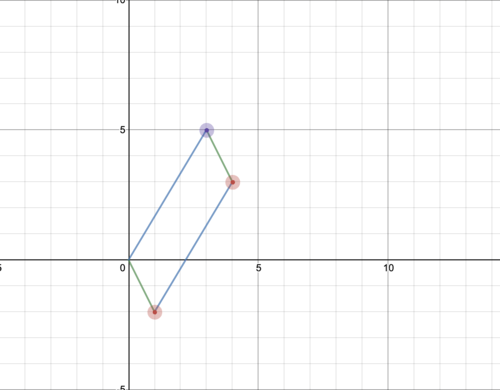带有决定因素的面积和数量
章节大纲
-
If we interpret determinants geometrically, we get some really beautiful formulas.
::如果我们对决定因素进行几何解释,我们就会得到一些非常美丽的公式。First off, given a 2x2 matrix has the property that that determinant is equal to the area of the parallelogram formed by those two vectors. And similarly, in a three by three case we get that the determinant is the volume of the parallelepiped formed by the three column vectors we see in the matrix.
::首先,如果给一个 2x2 矩阵 det ([a1a2b1b2]) , 则该决定因素的属性等于这两个矢量构成的平行图面积。 同样, 在三三三的情况下, 我们得到的决定因素是 由三列矢量构成的平行气管的体积 。Let's look at an example of this:
::举个例子:
::A=[x100x2]and the the columns of this form the vectors and looking at this as a rectangle gives us
::以此形状的列为矢量 [x10] , [0x2] , 并将它作为矩形来看待 。and the area equals which equals the determinant of A.
::区域等于x1x2,等于A的决定因素。Now, let's try and get a new matrix and the determinant becomes which is the area inside the parallelogram
::现在,让我们尝试获得一个新的矩阵 A = [x1x3x2x4] , 决定因素变成 x1x4 - x2x3, 这是平行图中的区域To prove that the determinant equals the area, we have to find the area of the parallelogram.
::为了证明决定因素与区域相等,我们必须找到平行图的区域。What is actually interesting is that any matrix can be transformed into a diagonal matrix.
::真正有趣的是,任何矩阵都可以转换成对角矩阵。We know from geometry that given a matrix with columns of vectors and we know that the area of a parallelogram formed by the vectors of has the same area, given a scalar c, as the parallelogram formed by the vectors so hence we can shift the vectors to make it into a diagonal matrix and write the vector as the product of the lengths of the vectors.
::我们从几何学中得知,给定了一个矢量为 v1[x1x2],v2[x3x4]的矩阵,我们知道,由 v1,v2的矢量构成的平行图区域与由矢量v1,v2cv1组成的平行图区域具有相同的区域,与由矢量v1,v2cv1组成的平行图区域相同,因此我们可以将矢量转换成对等矩阵,并将矢量写成矢量长度的产物。Let's look at some more examples,
::让我们再举几个例子,
::A=[1-235]This gives us the vectors
::这给了我们矢量The area of this is 11 which is also equal to the determinant of the matrix A.
::这方面有11个领域,也相当于矩阵A的决定因素。If we want to generalize this to higher dimensions, we get that the determinant of an n dimensional matrix is essentially the space (area in 2d, volume in 3d, whatever in 4d ) between all of the column vectors.This looks like the volume of a parallelipiped in 3 dimensions.Try some of these problems to gauge volume of a parallelipedGraph the parallelipied formed by the column vectors ofand then calculate the volume.To do this, we take the matrix:On your own, try to graph this image.
